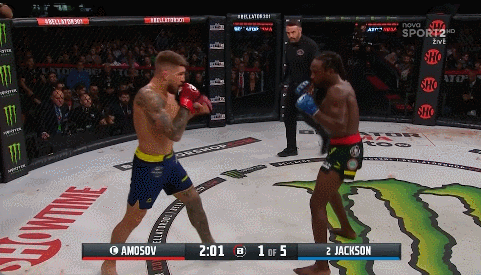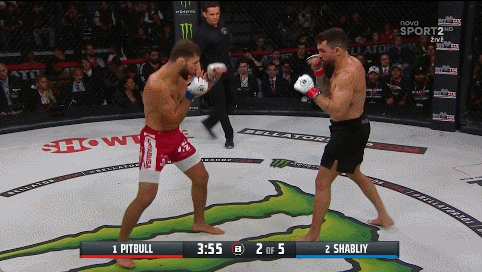How Patchy Mix
~ Killed the King ~
Patchy Mix dispatched Sergio Pettis with little difficulty to upgrade his Bellator bantamweight belt from “interim” to “the real deal” on Friday night. While Bellator seems to have wheezed to a halt with the lightweight grand prix ongoing, this bantamweight tournament was provided with perfect closure in the emergence of Mix as a world class bantamweight.
Pettis was always going to be in trouble against a strong, long wrestler with good cage awareness because for as smooth as he can be, he simply doesn’t have the pop to keep opponents off him. The first round was spent with Mix effectively pressuring Pettis and drawing out his counters and reactions, before taking top position and ending the round there. In round two, Mix executed another takedown along the fence and as Pettis jumped up to his feet, Mix executed the rarely seen Jacare back take. Figure 1 shows the action.
As Pettis jumps up from his knees (a), Mix inserts his right foot as a hook on the cage side (b). Mix switches from a back bodylock to a seatbelt grip by throwing his right arm over Pettis’ shoulder (c). With the seatbelt and a hook secured, Mix wants to throw Pettis to the floor, away from the fence. To accomplish this he places his left foot on the fence (d) and launches himself towards the centre of the cage (e). Pettis falls to the mat (f) but rolls across to try and get his hips to the mat on the side that Mix does not have a hook in (g).
Fig. 1
Examples of this technique are scant, but Jacare Souza introduced it against Bristol Marunde in Strikeforce. The other notable instance took place in the UFC and, curiously enough, the older Pettis brother was on the receiving end as Diego Ferreira took his back.
Once Patchy Mix had consolidated his backpack position on Pettis, he ran through the classic Danaher Death Squad handfighting sequence to secure the finish. Figure 2 shows the intricate little sequence.
Mix has back control with his legs locked in a body triangle and both arms underneath Pettis’ (a). He frees his right hand to attack the choke on the top side (b) but Pettis brings his own right arm up to “answer the phone” and Mix grabs the wrist. Using his right hand, Mix shoves Pettis’ right hand down towards his beltline (c), at which point his left hand—still underneath Pettis’ left arm—catches a grip across the body on Pettis’ right wrist (d). This allows Mix to throw his right leg over the top of Pettis’ right wrist (e) and work towards his elbow. Pettis’ right arm is now trapped by Mix’s right leg, while Pettis’ left arm is control at the wrist by Mix’s left hand. This leaves Mix’s right arm free to work underneath Pettis’ chin and secure a snug fit for the choke (f). When Mix wants to squeeze for the finish he releases his grip on Pettis’ left hand and races to join his hands behind Pettis’ shoulder (g).
Fig. 2
In the main event, Jason Jackson picked up his seventh win on the trot, his first knockout in five years, and the Bellator welterweight crown to boot. Against the incredibly highly touted Yaroslav Amasov, Jackson was able to use his strong wrestling and a counter right uppercut to terrific effect.
Fig. 3
It was one of those classic MMA performances where the perfect all rounder—Amasov—suddenly looked very limited and ordinary when one aspect of his game stopped working. Instead of assessing the problem and trying to adapt, Amasov fell victim to tunnel vision and simply tried to dipping jab into the clinch more frequently.
There were openings for Amasov because Jackson was focused entirely on getting his hips back and throwing the counter uppercut off Amasov’s jab. Amasov threw up a left high kick in the first round which almost did Jackson in as Jackson was caught loading up his right uppercut down by his waist.
Fig. 4
Obviously the left high kick comes with a host of its own hazards, but counter uppercut is a pretty exploitable look if shown consistently. Good left hooks are the obvious one, but even leading with a slapping left hook would at least serve the purpose of keeping Jackson out of the slip and away from the counter uppercut. Shoulder feinting the jab and throwing the right straight across yourself is another excellent counter to an opponent who always slips to the elbow side of the jab.
The best MMA striking performance of the weekend came from the casually brilliant Alexandr Shabliy. Against Patricky Pitbull, Shabliy had a field day with his jab, his right straight, his counter left hook and most interestingly, his front kick.
Shabliy has managed to turn his rear leg front snap kick into a double attack with his calf kick. In an MMA landscape where the calf kick is long range artillery fire, thrown from a run up, Shabliy has turned it into a double attack with the front snap kick by encroaching on his opponent and making sure to throw both from the same distance.
Fig. 5
By focusing much of his offence around the rear leg front kick, Shabliy is able to use the cross step that Sean O’Malley loves. Front kicking is a great means to switch stances and to change from a squared position—Shabliy’s ordinary stance—to a bladed one, necessary for spinning techniques. Figure 6 shows Shabliy throwing his right front kick from orthodox, dropping it to the floor just in front of his left foot, and retreating with his left leg so that he is both southpaw and bladed in his stance (e).
Fig. 6
Not only does this get the fighter into position to spin, it does so in a way that appears outwardly vulnerable. Crossing yourself up is so seldom advantageous that most fighters will step in the moment your front kick is parried or glances across their body. By retreating into a bladed stance off the kick, Shabliy puts himself into position to score a counter backfist or back kick.
Fig. 7
This is different to the way that Shabliy scored his wheel kick off a missed front kick in the final round though. That was done advancing—he did not kick and then step down, replacing his standing foot with his kicking foot. Instead he stepped through with his kicking leg and advanced into the spin.
Finally, let us briefly touch on Paul Craig versus Brendan Allen. It was another classic case of Paul Craig losing to a positionally sound grappler with decent wrestling. While Craig has the kick-and-frame striking style of other famous grapplers like Aljamain Sterling and Jon Jones, it falls short because his wrestling is so mediocre. His success rate on takedowns is just north of twenty percent, and going down a weightclass hasn’t allowed him to muscle around smaller men in the way many hoped.
But Craig still shows glimpses of craftiness on the bottom. After getting thrown off a whizzer along the fence and mounted, Craig demonstrated a good elbow escape in an MMA context and some fun lockdown work. Figure 8 starts the action.
As Allen begins dropping strikes (a), Craig turns to his front as if to expose his back (b). As he drops his hips back to the mat he is able to catch Allen’s ankle with his top leg and slide his bottom leg underneath (c). From here he can swallow Allen’s knee between his thighs (d), reclaiming half guard. Craig immediately throws his outside leg—his right leg—over the top of Allen’s trapped leg, and locks it behind his own left knee. His left ankle laces underneath Allen’s and he acquires the lockdown (e).
Fig. 8
The lockdown is a great stalling position, and some grapplers are capable of generating real movement with it. Figure 9 shows the difficulty Craig was having. He could extend his legs out to his right (a) and off balance and extend Allen in that way, but to wrestle up he would need to get Allen’s weight to the opposite side of his body and come up on his right underhook. After some trouble getting going, Craig did something very crafty.
Passing his left arm from around Allen’s waist (b), to the opposite side (c), Craig seemingly exposed his back to Allen but reached down and grabbed the trapped foot (d). Pulling this foot up towards him, Craig attacked a calf slicer (e) which forced Allen to let go of him and begin turning (f), eventually exposing his back for a scramble (g). Not a bad turn after starting in one of MMA’s worst positions.
Fig. 9
The fascinating thing about this technique is that it predates most of the modern lockdown game. Eddie Bravo—who popularized lockdown half guard—has discussed trying to chase the calf crank from the lockdown half guard in this way. Because this method was too obvious and too silly, he developed the idea into the electric chair sweep and rolling calf crank—which I believe Bravo calls the vaporizer. Bravo himself is still the only guy capable of doing it at high levels but his Metamoris match with Royler Gracie contains a beautiful example. It takes about four minutes for Bravo to get through his electric chair sweep to rolling calf crank sequence but it is well worth the watch.
Fig. 10
The best fight of the weekend though was undoubtedly Raufeon Stots versus Danny Sabatello II, which was chock full of scrambles, sweeps, takedowns, and a surprising amount of Sabatello genuinely going for it on the feet.










